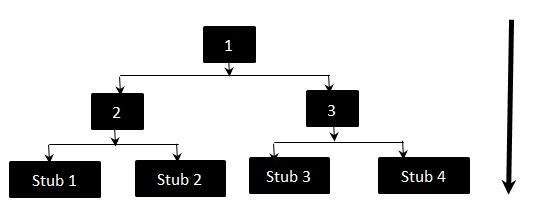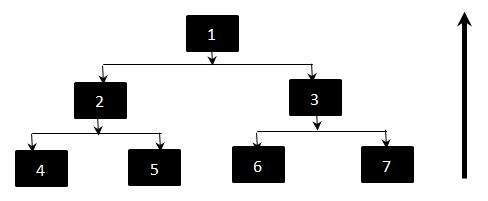- Big-Bang Strategy
- Top Down Strategy
- Bottom Up Strategy
- Hybrid Strategy
- All components or modules are integrated simultaneously
- Individual modules are not integrated until all the modules are ready
- This approach is generally executed by those developers who follows the ‘Run it and see’ approach.
- Because of integrating everything at one time if any failures occurs then it become very difficult for the programmers to know the root cause of that failure.
- In case any bug arises then the developers has to detach the integrated modules in order to find the actual cause of the bug.
- Top-down integration testing is an integration testing technique used in order to simulate the behaviour of the lower-level modules that are not yet integrated
- Stubs are the modules that act as temporary replacement for a called module and give the same output as that of the actual product
- The replacement for the 'called' modules is known as 'Stubs' and is also used when the software needs to interact with an external system
- It is viewed as three layers; viz - The Main Target Layer, a layer above the target layer and a layer below the target layer.
- Testing is mainly focussed for the middle level target layer and is selected on the basis of system characteristics and the structure of the code.
- Hybrid Integration testing can be adopted if the customer wants to work on a working version of the application as soon as possible aimed at producing a basic working system in the earlier stages of the development cycle.
- Controller tests
- Integration tests
- Acceptance tests
- also known as 'functional tests'
- also can be used as integration tests, especially as integration tests for backend
- provide some kind of end-to-end testing (controller params as input and http response code & name of rendered template as output)
- good for API integration tests
- they’re able to simulate complex interactions utilizing more of the application stack
- they feed simulated HTTP requests to the Rails Dispatcher rather than through the controller
- integration tests don’t map directly to any specific source file
- from 5x to 10x slower, depending on test complexity
- allows to tests the WHOLE application including frontend
- Tests are defined with a user-oriented API that mirrors the actions a user would perform
- includes script and stylesheet evaluation
- helps you test web applications by simulating how a real user would interact with your app
- Pluggable back-end drivers that give you several options ranging from simple (markup only) to the full-featured (full evaluation of Javascript and CSS styles)
- A slick, natural API that allows tests to be defined in language that mimics user interaction with the browser
- Management of multiple sessions
- Automatic following of redirect responses
- Ability to follow external URLs
- install phantomjs
-
In Gemfile
gem 'capybara' gem 'poltergeist' -
In rails_helper:
require 'capybara/poltergeist' require 'capybara/rspec' Capybara.javascript_driver = :poltergeist
Integration testing
Integration testing is a logical extension of unit testing. In its simplest form, two units that have already been tested are combined into a component and the interface between them is tested.
Integration testing
The purpose of integration testing is to verify the functional, performance, and reliability between the modules that are integrated.
Integration testing strategies
Big-Bang Strategy
Top Down Strategy

Top Down Strategy
Bottom Up Strategy

Each component at lower hierarchy is tested individually and then the components that rely upon these components are tested.
Hybrid Strategy

In Hybrid Integration Testing, we exploit the advantages of Top-down and Bottom-up approaches. As the name suggests, we make use of both the Integration techniques.
Hybrid Strategy
Three Options for Top-Down Rails Testing
Controller tests
Rails Integration test itself
Rails Integration test itself
class ShopperInteractionsTest < ActionDispatch::IntegrationTest
test "place order and check orders admin" do
shopper = login_as users(:user)
admin = login_as users(:administrator)
product = products(:rails_book)
shopper.post line_items_path, line_item: { product_id: product.id }
shopper.follow_redirect!
assert_equal root_path, shopper.path
order_params = {
name: "Chris Kottom",
address: "My house",
email: "chris@example.com",
pay_type: "Credit Card"
}
assert_difference "Order.count" do
shopper.post orders_path, order: order_params
end
shopper.follow_redirect!
assert_equal root_path, shopper.path
order = Order.last
admin.get orders_path
admin.assert_select "#orders #order_#{ order.id }" do
admin.assert_select "a[href=?]", order_path(order.id)
end
end
end
Acceptance Tests
Capybara
Capybara
Capybara: Code Example
RSpec.describe HomeController do
describe "contact form" do
before { visit '/' }
context "with valid message" do
it "sends the letter" do
within("#section6") do
fill_in "contact_message_name", with: "Sergiy"
fill_in "contact_message_email", with: 'sergey.kukunin@gmail.com'
select "Just Saying Hi", :from => "contact_message_subject"
fill_in "contact_message_body", with: "Glad to meet you"
end
expect { click_on "SEND" }.to change { ActionMailer::Base.deliveries.count }.by(1)
expect(page).to have_content("Thank you for contacting us.")
end
end
end
describe "licenses" do
it "shows all licenses" do
visit licenses_path
expect(page).to have_selector "table", count: 2
expect(page).to have_selector "table:nth-child(1) tbody tr", count: 2
expect(page).to have_selector "table:nth-child(1) thead", text: 'CA'
end
end
end
Capybara: Setup
Capybara: CheatSheet
Navigation
visit('/projects')
visit(post_comments_path(post))
Capybara: Clicking links and buttons
click_link('id-of-link')
click_link('Link Text')
click_button('Save')
click('Link Text') # Click either a link or a button
click('Button Value')
Capybara: Interaction with forms
fill_in('First Name', :with => 'John') fill_in('Password', :with => 'Seekrit') fill_in('Description', :with => 'Really Long Text…') choose('A Radio Button') check('A Checkbox') uncheck('A Checkbox') attach_file('Image', '/path/to/image.jpg') select('Option', :from => 'Select Box')
Capybara: Scoping
within("//li[@id='employee']") do
fill_in 'Name', :with => 'Jimmy'
end
within(:css, "li#employee") do
fill_in 'Name', :with => 'Jimmy'
end
within_fieldset('Employee') do
fill_in 'Name', :with => 'Jimmy'
end
within_table('Employee') do
fill_in 'Name', :with => 'Jimmy'
end
Capybara: Querying
page.has_xpath?('//table/tr')
page.has_css?('table tr.foo')
page.has_content?('foo')
page.should have_xpath('//table/tr')
page.should have_css('table tr.foo')
page.should have_content('foo')
page.should have_no_content('foo')
find_field('First Name').value
find_link('Hello').visible?
find_button('Send').click
find('//table/tr').click
locate("//*[@id='overlay'").find("//h1").click
all('a').each { |a| a[:href] }
Capybara: Scripting
result = page.evaluate_script('4 + 4');
Capybara: Debugging
save_and_open_page
Capybara: XPath and CSS
within(:css, 'ul li') { ... }
find(:css, 'ul li').text
locate(:css, 'input#name').value
Capybara.default_selector = :css
within('ul li') { ... }
find('ul li').text
locate('input#name').value
